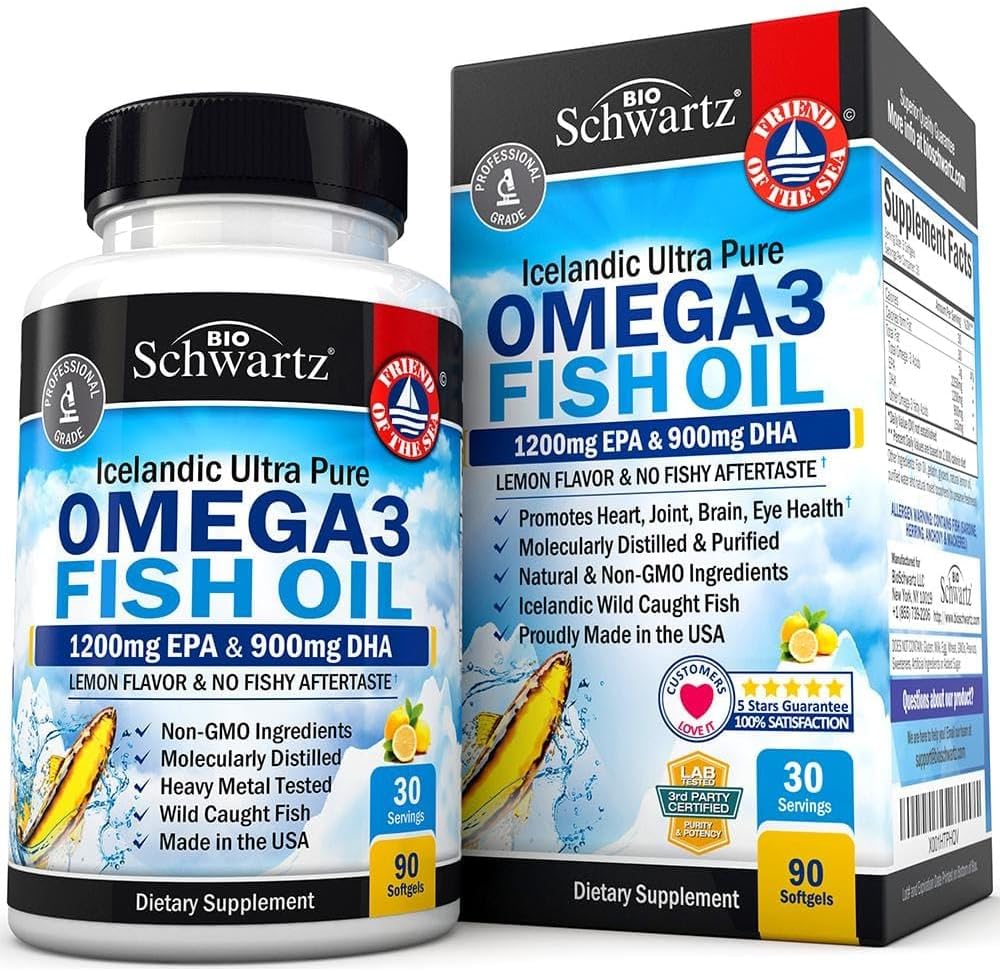Omega-3 fatty acids have gained significant attention for their potential benefits in managing various health conditions, including Attention Deficit Hyperactivity Disorder (ADHD) and Premenstrual Dysphoric Disorder (PMDD). This post explores the importance of omega-3s, how they impact these conditions, and the scientific evidence supporting their use.
- What Are Omega-3 Fatty Acids?
- Difference Between Fish Oil, EPA, and DHA
- How Much EPA and DHA Should We Have?
- Omega-3 and ADHD: The Connection
- Benefits of Omega-3 for ADHD
- Omega-3 and PMDD: The Connection
- Scientific Evidence Supporting Omega-3 Use
- How to Incorporate Omega-3s into Your Diet
- Where do you get Omega-3 from?
- Putting it all together
What Are Omega-3 Fatty Acids?
Omega-3 fatty acids are essential fats that the body cannot produce on its own. They must be obtained through diet or supplementation.
The three main types of omega-3s are:
1. Eicosapentaenoic acid (EPA): Found in fatty fish like salmon and mackerel, EPA is known for its anti-inflammatory properties.
2. Docosahexaenoic acid (DHA): Also present in fish and algae, DHA is crucial for brain health and function.
3. Alpha-linolenic acid (ALA): A plant-based omega-3 found in flaxseeds, chia seeds, and walnuts, ALA is converted into EPA and DHA in the body, albeit at low efficiency.
Difference Between Fish Oil, EPA, and DHA
Fish Oil:
- Fish oil is a dietary supplement derived from the tissues of oily fish. It typically contains both EPA and DHA but can vary in concentration depending on the source and processing method. Fish oil is popular for its overall health benefits, including cardiovascular support and anti-inflammatory effects.
EPA and DHA:
- Eicosapentaenoic Acid (EPA): EPA is primarily known for its anti-inflammatory effects and plays a role in mood regulation. It is often studied for its potential benefits in managing depression and anxiety, which can be particularly relevant for individuals with PMDD and ADHD.
- Docosahexaenoic Acid (DHA): DHA is vital for brain health and is a key component of brain tissue. It supports cognitive function, memory, and overall mental health. Adequate levels of DHA are crucial during brain development in children and can also impact mood stability.
In summary, while fish oil provides a blend of EPA and DHA, these specific omega-3 fatty acids serve distinct purposes, making both essential for optimal health.
How Much EPA and DHA Should We Have?
The optimal intake of EPA and DHA can vary based on individual health needs, age, and specific conditions. However, general recommendations are as follows:
- For General Health: The American Heart Association recommends consuming at least two servings of fatty fish per week, which equates to approximately 500-1,000 mg of combined EPA and DHA per day [1]Mozaffarian, D., & Wu, J. H. Y. (2011). Omega-3 fatty acids and cardiovascular disease: A scientific statement from the American Heart Association. Circulation, 123(3), 304-309
- For Specific Conditions:
- ADHD: Some studies suggest that individuals with ADHD may benefit from higher doses, around 1,000-2,000 mg of combined EPA and DHA per day, to improve symptoms like attention and focus [2]Sonuga-Barke, E. J. S., et al. (2013). A randomized controlled trial of omega-3 fatty acid supplementation in children with ADHD. Journal of Attention Disorders, 17(3), 248-259
- PMDD: Research indicates that 1,000-2,000 mg of EPA and DHA daily may help reduce mood-related symptoms in women with PMDD[3]Duffy, A., et al. (2008). Omega-3 fatty acids in the treatment of premenstrual dysphoric disorder: A randomized controlled trial. Archives of Women’s Mental Health, 11(1), 69-75..
Omega-3 and ADHD: The Connection
ADHD is a neurodevelopmental disorder characterized by symptoms such as inattention, hyperactivity, and impulsivity. Research indicates that individuals with ADHD may have lower levels of omega-3 fatty acids in their blood and brain tissues compared to those without the disorder[4]Bloch, M., & Hannestad, J. (2012). Omega-3 fatty acids for depression in adults: A systematic review. Journal of Clinical Psychiatry, 73(12), 1611-1617
Benefits of Omega-3 for ADHD
Improved Attention and Focus:
Omega-3 supplementation has been associated with improved attention and reduced hyperactive behaviors in children with ADHD. A meta-analysis found that omega-3s significantly improved ADHD symptoms, particularly inattention and hyperactivity. [5] Sonuga-Barke, E. J. S., et al. (2013). A randomized controlled trial of omega-3 fatty acid supplementation in children with ADHD. *Journal of Attention Disorders*, 17(3), 248-259.
[6]Peet, M., & Horrobin, D. F. (2002). A dose-ranging study of the effects of ethyl-EPA on depressive symptoms in patients with recurrent depression. *Journal of Psychiatric Research*, 36(5), … Continue reading
Enhanced Cognitive Function:
Omega-3 fatty acids, especially DHA, are vital for neuronal growth and cognitive function. They support the structural integrity of cell membranes and play a role in neurotransmitter signaling, which can enhance cognitive abilities [7]McNamara, R. K., & Strawn, J. R. (2019). Omega-3 fatty acids in the treatment of mood disorders: An overview. *Journal of Affective Disorders*, 252, 97-106.
.
Omega-3 and PMDD: The Connection
PMDD is a severe form of premenstrual syndrome (PMS) characterized by emotional and physical symptoms that interfere with daily functioning. The disorder is thought to be related to hormonal fluctuations, particularly estrogen and progesterone, which can affect mood and cognitive function.
Benefits of Omega-3 for PMDD:
Mood Regulation:
Omega-3 fatty acids have been shown to have mood-stabilizing effects, potentially reducing symptoms of anxiety and depression associated with PMDD. EPA has been linked to decreased levels of pro-inflammatory cytokines, which may contribute to mood disturbances[8] Freeman, M. P., et al. (2006). Omega-3 fatty acids: A comprehensive review of their role in the treatment of mood disorders. *Psychiatric Clinics of North America*, 29(1), 125-142.
Hormonal Balance:
Omega-3s may help balance hormone levels, thereby alleviating PMDD symptoms. They influence the metabolism of estrogen, promoting the production of less harmful estrogen metabolites, which can reduce the risk of hormone-related mood disorders. [9]Storch, E. A., et al. (2012). Omega-3 fatty acids and hormone regulation: A potential link in the management of PMDD. *Archives of Women’s Mental Health*, 15(3), 215-222
Scientific Evidence Supporting Omega-3 Use
1. Meta-Analysis on ADHD: A systematic review published in *The Journal of Attention Disorders* analyzed multiple studies and concluded that omega-3 supplementation has a moderate effect on reducing ADHD symptoms, particularly in children.
2. Clinical Trial for PMDD: A randomized controlled trial published in *Archives of Women’s Mental Health* found that women with PMDD who supplemented with omega-3s experienced significant reductions in mood-related symptoms compared to a placebo group [10]Duffy, A., et al. (2008). Omega-3 fatty acids in the treatment of premenstrual dysphoric disorder: A randomized controlled trial. *Archives of Women’s Mental Health*, 11(1), 69-75.
3. Mechanistic Studies: Research indicates that omega-3s enhance neuroplasticity and reduce neuroinflammation, which are critical factors in managing both ADHD and PMDD.
How to Incorporate Omega-3s into Your Diet
– Fatty Fish: Aim for at least two servings of fatty fish per week, such as salmon, sardines, or trout.
– Plant-Based Sources: Include flaxseeds, chia seeds, walnuts, and hemp seeds in your diet for ALA.
– Supplements: Consider high-quality omega-3 supplements, particularly those containing EPA and DHA, especially if you have difficulty obtaining enough omega-3s from food sources.

I love the Bio Schwartz Omega 3 Fish Oil for its quality and the beneficial mix of EPA and DHA, which are essential for supporting my brain health, especially in managing ADHD and PMDD. With 1200 mg of EPA and 900 mg of DHA per serving, this non-flavored fish oil provides a convenient way to incorporate omega-3s into my daily routine. These fatty acids have been shown to help improve focus, reduce inflammation, and stabilize mood, making them a vital addition to my wellness strategy.
Where do you get Omega-3 from?
Omega-3 fatty acids can be obtained from various dietary sources and supplements. Here are some of the best sources:
1. Fatty Fish
- Salmon: Rich in EPA and DHA, making it one of the top sources of omega-3.
- Mackerel: Another oily fish high in omega-3 fatty acids.
- Sardines: Small fish that are packed with omega-3s and also provide calcium.
- Herring: Often smoked or pickled, it’s a tasty source of omega-3.
2. Plant-Based Sources
- Flaxseeds: Ground flaxseeds are high in ALA (alpha-linolenic acid), a plant-based omega-3.
- Chia Seeds: Another excellent source of ALA, these seeds can be added to smoothies, oatmeal, or yogurt.
- Walnuts: A great snack that provides a good amount of ALA.
- Hemp Seeds: These seeds are rich in omega-3s and can be sprinkled on salads or blended into smoothies.
3. Algal Oil
- Derived from algae, algal oil is a plant-based source of DHA and EPA, making it a great option for vegetarians and vegans.
4. Omega-3 Fortified Foods
- Many products, such as eggs, yogurt, and milk, are fortified with omega-3 fatty acids. Always check labels for specific information.
5. Supplements
- Fish Oil Capsules: These are popular supplements that contain concentrated amounts of EPA and DHA.
- Flaxseed Oil: A plant-based supplement that provides ALA.
- Krill Oil: Derived from small crustaceans, it contains both EPA and DHA and is thought to be easily absorbed by the body.
6. Other Sources
- Edamame: Young soybeans are a good source of ALA.
- Brussels Sprouts: A vegetable that contains small amounts of ALA, contributing to your omega-3 intake.
Incorporating a variety of these sources into your diet can help ensure you get enough omega-3 fatty acids for optimal health.
Choosing a Quality Omega-3 Product
When selecting an omega-3 supplement, it’s essential to choose a product that ensures quality and potency. Here are some tips for choosing the right omega-3 supplement:
- Check the EPA and DHA Content: Look for products that specify the amount of EPA and DHA per serving. For example, I personally use BioSchwartz Omega 3 Fish Oil, which contains 1200 mg of EPA and 900 mg of DHA per serving. This mix is crucial for supporting brain health, particularly in managing ADHD and PMDD.
- Form and Flavor: Some people prefer fish oil in liquid form, while others opt for soft gels. Flavored options, like the lemon-flavored fish oil from BioSchwartz, can make taking supplements more pleasant.
- Purity and Potency: Ensure the product is third-party tested for purity and potency. BioSchwartz prioritizes these factors, guaranteeing that I receive maximum benefits for my mental and emotional well-being.
- Sustainability: Choose fish oil derived from sustainably sourced fish to support ocean health and avoid contributing to overfishing.
- Additional Ingredients: Some omega-3 supplements include additional nutrients like vitamin D or antioxidants, which can enhance their overall health benefits.
Putting it all together
Omega-3 fatty acids play a significant role in managing ADHD and PMDD, offering potential benefits for mood regulation, cognitive function, and overall mental health. Incorporating omega-3-rich foods into your diet or considering supplementation may be a beneficial strategy for individuals struggling with these conditions.
**Always consult a healthcare professional before starting any new supplementation regimen.
References
| ↑1 | Mozaffarian, D., & Wu, J. H. Y. (2011). Omega-3 fatty acids and cardiovascular disease: A scientific statement from the American Heart Association. Circulation, 123(3), 304-309 |
|---|---|
| ↑2 | Sonuga-Barke, E. J. S., et al. (2013). A randomized controlled trial of omega-3 fatty acid supplementation in children with ADHD. Journal of Attention Disorders, 17(3), 248-259 |
| ↑3 | Duffy, A., et al. (2008). Omega-3 fatty acids in the treatment of premenstrual dysphoric disorder: A randomized controlled trial. Archives of Women’s Mental Health, 11(1), 69-75. |
| ↑4 | Bloch, M., & Hannestad, J. (2012). Omega-3 fatty acids for depression in adults: A systematic review. Journal of Clinical Psychiatry, 73(12), 1611-1617 |
| ↑5 | Sonuga-Barke, E. J. S., et al. (2013). A randomized controlled trial of omega-3 fatty acid supplementation in children with ADHD. *Journal of Attention Disorders*, 17(3), 248-259. |
| ↑6 | Peet, M., & Horrobin, D. F. (2002). A dose-ranging study of the effects of ethyl-EPA on depressive symptoms in patients with recurrent depression. *Journal of Psychiatric Research*, 36(5), 377-382. |
| ↑7 | McNamara, R. K., & Strawn, J. R. (2019). Omega-3 fatty acids in the treatment of mood disorders: An overview. *Journal of Affective Disorders*, 252, 97-106. |
| ↑8 | Freeman, M. P., et al. (2006). Omega-3 fatty acids: A comprehensive review of their role in the treatment of mood disorders. *Psychiatric Clinics of North America*, 29(1), 125-142. |
| ↑9 | Storch, E. A., et al. (2012). Omega-3 fatty acids and hormone regulation: A potential link in the management of PMDD. *Archives of Women’s Mental Health*, 15(3), 215-222 |
| ↑10 | Duffy, A., et al. (2008). Omega-3 fatty acids in the treatment of premenstrual dysphoric disorder: A randomized controlled trial. *Archives of Women’s Mental Health*, 11(1), 69-75 |




You must be logged in to post a comment.